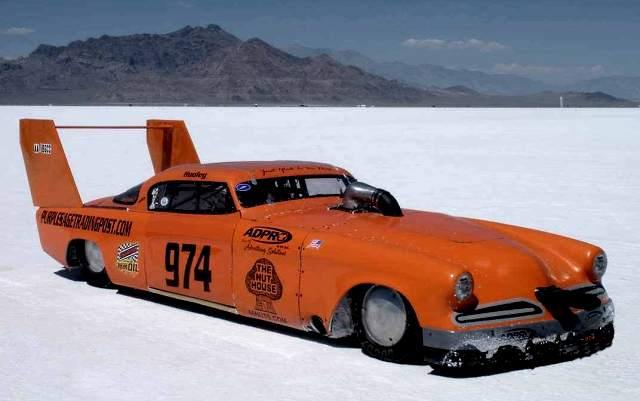.... Sumner...Not sure what your comparing, Jacks 122.99 max G motor 360 mph hood scoop looks bigger than Hooley's 400 cu.in. scoop.
His is smaller, it was the perspective of the picture. Here is a better one of his scoop...

.....I would never put that small a scoop on the 222 Camaro.
JL222 
Nor would I recommend one that size. Not sure if you ran through the formula or not but besides how far the car travels in 2 engine revolutions (figured by gearing and tire size) the other two factors are displacement and if it is naturally aspirated or blown. A motor running 14-15 lbs. of boost compared to na is going to need about twice the scoop opening and if you were running 18-30 #'s 3 times the scoop opening.
For instance with Hooley's old motor, 400 ci, with 28 inch tires and 2.47 rear the scoop size with a 10% oversize would be:
na = 6.5 sq. in.
8# boost = 10 sq. in.
15# boost = 13 sq. in.
28# boost = 19 sq. in.
Since we ran an overdrive 4th gear our real final ratio was about 2.22. That would of resulted in openings smaller than above since the car went further each 2 revolutions but I used the 2.47 which also oversize the scoop some. We also never had much luck with the roots blower over about 8-10 #'s since the air got too hot with no intercooler and I think we made less HP down at the 4-5 as a result vs. running less boost. We also ran the car extremely rich, in the low 10's which I felt kept the motor together. Other than forgetting to turn the cooling water on never hurt the motor on a lot of runs to the 5 mile and even then no piston damage.
The 572 that is in the car now won't be run over 14-15 #'s with the present turbos so the opening for it is sized at about 24 sq. in. (3 X 8 inches) even though the formula says 17 sq. in.. This gives us some leeway if we got better turbos at some point.
Sparky makes a good point in that this is more critical with a streamliner or lakester if there is nothing behind the scoop except hopefully clean air. Our present scoop...

... has the whole car behind it sitting down there at the front of the car

.
Good luck to you guys this year,
Sum